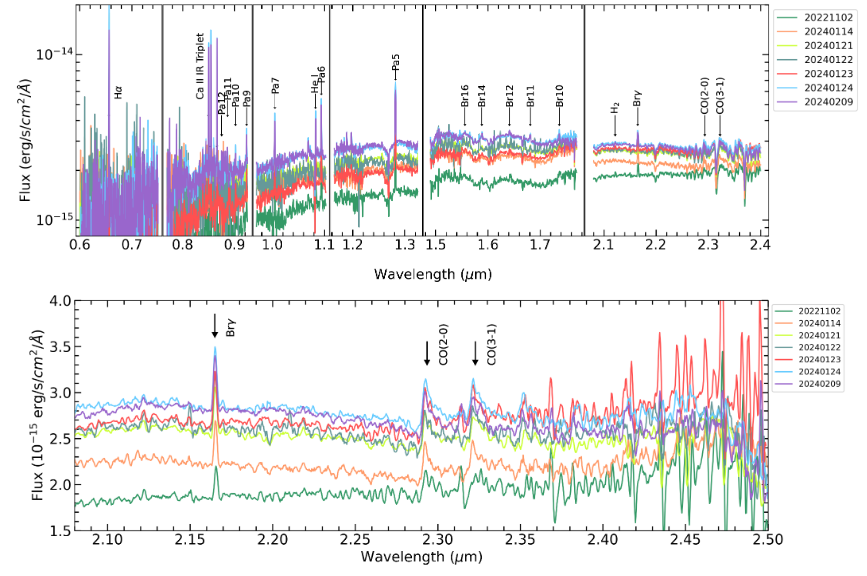
We present a detailed analysis of the long-term photometric and spectroscopic evolution of V1180 Cas over a decade, aiming to identify the dominant mechanisms behind its variability. We combine multi-band light curves from 1999 to 2025 with over 30 epochs of optical to near-infrared spectroscopy (0.5-2.5 μm), analyzing variability patterns, color behavior, and emission line diagnostics. We investigate the temporal evolution of accretion and outflow indicators and their correlation with photometric states. The light curve reveals a transition from sporadic early dimming events to a quasi-periodic pattern since 2018, with eleven major dips showing asymmetry and stochastic sub-structure. Color-magnitude diagrams show classic UXor-like blueing during deep minima, while near-infrared and mid-infrared color changes indicate thermal evolution of disk. Spectroscopic analysis reveals persistent hydrogen, Ca II, He I, and forbidden line emission. Accretion diagnostics track photometric variability, and forbidden lines often intensify during dips, implying a physical link between extinction and outflows. Estimated accretion rates range from ˜108−107 solar mass/yr; the outflow rate and density diagnostics are consistent with disk winds and shock-excited jets. V1180 Cas demonstrates dual-mode variability driven by both variable circumstellar extinction and episodic accretion events. The hybrid UXor/EXor behavior, combined with evolving disk signatures and persistent outflows, suggests a young stellar object undergoing coupled accretion-extinction-outflow evolution. Continued monitoring will be essential to fully resolve the physical processes shaping its variability.
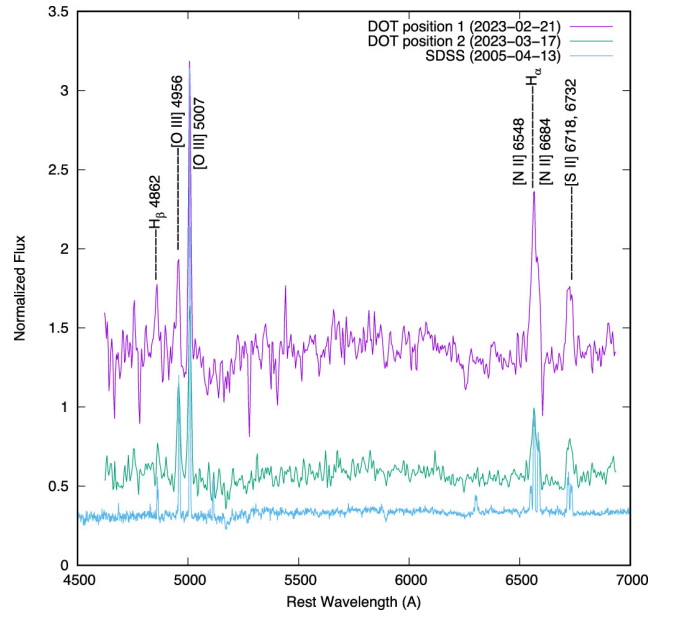
We present multiband follow-up observations of the supermassive binary black hole (BBH) candidate and misaligned double–double radio galaxy, J1328+2752. To investigate its parsec-scale structure, we have carried out observations with the Very Long Baseline Array (VLBA) and the European Very Long Baseline Interferometry (VLBI) Network. Additionally, we have obtained optical spectroscopic observations with the 3.6 m Devasthal Optical Telescope. Within 3.5 yr of our previous VLBI observations, the central parsec-scale radio structure of J1328+2752 has changed from a double component to a single central component and its flux density has increased by a factor of 3 in the 5 GHz VLBA observations. The new radio component is largely unresolved at 3, 5, and 8 GHz. The multifrequency radio data shows a convex-shaped spectrum for this unresolved component. The turnover frequency is at ∼3 GHz. While the total intensity image does not reveal any details, a super-resolved VLBA 5 and 8 GHz spectral index image does indicate the presence of two components at a separation of ∼4.2 pc with spectral indices ‑0.5 ± 0.3 and ‑0.9 ± 0.3. We have not observed a simultaneous change in the optical line profiles or intensities over the past few years. The radio structure, the variation of the flux density, and spectral shape can potentially be consistent both with the signature of a young radio source or a BBH at the center of J1328+2752.
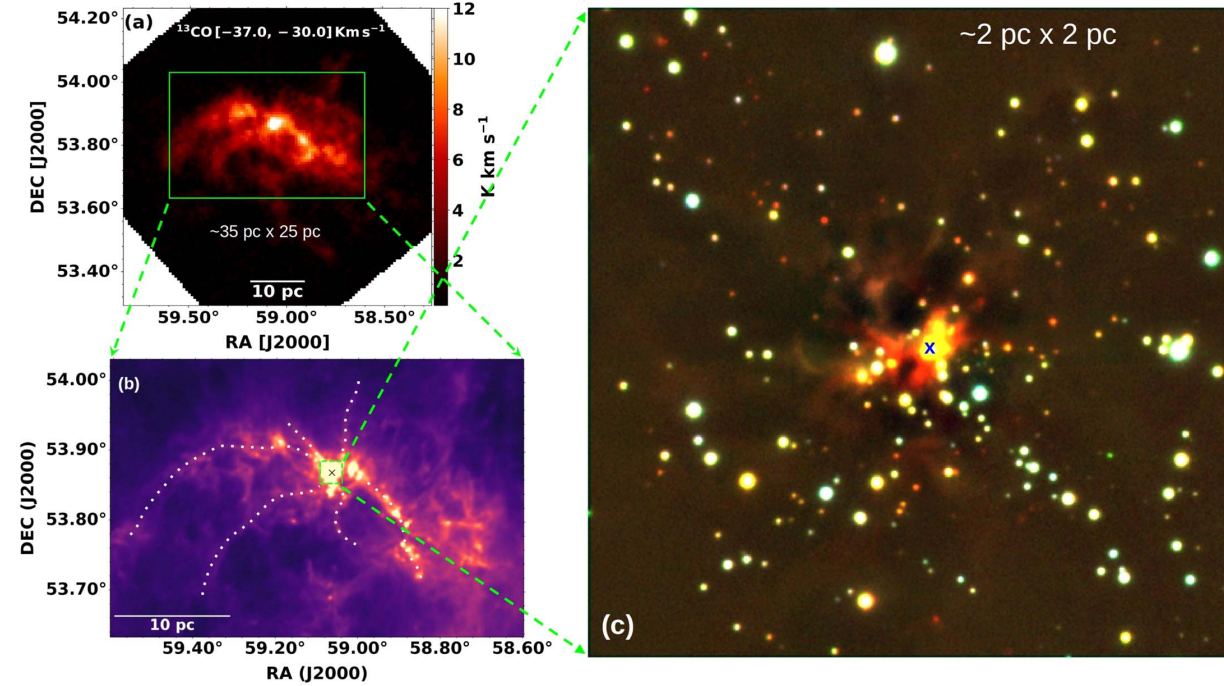
We present a detailed near-infrared study of an embedded cluster located in the hub of the giant molecular cloud G148.24+00.41 of mass ∼105 M ⊙, with the TANSPEC instrument mounted on the 3.6 m Devasthal Optical Telescope. The hub is located near the geometric center of the cloud and represents its most massive clump. We studied the central 2 pc × 2 pc area of the hub with 5σ limiting magnitudes of 20.5, 20.1, and 18.6 mag in the J, H, and K s bands, respectively. Using the K s -band luminosity function and comparing it with the synthetic clusters, we obtained the age of the cluster as ∼0.5 Myr, which was found to corroborate well with the visual extinction versus the age of nearby embedded clusters. We find that the present mass of the cluster is around ∼180 M ⊙, and the cluster is currently forming stars at a rate of ∼330 M ⊙ Myr‑1, with an efficiency of ∼20%. The cluster is connected to an extended gas reservoir through a filamentary network; thus, we hypothesize that the cluster has the potential to become a richer cluster in a few Myr of time.
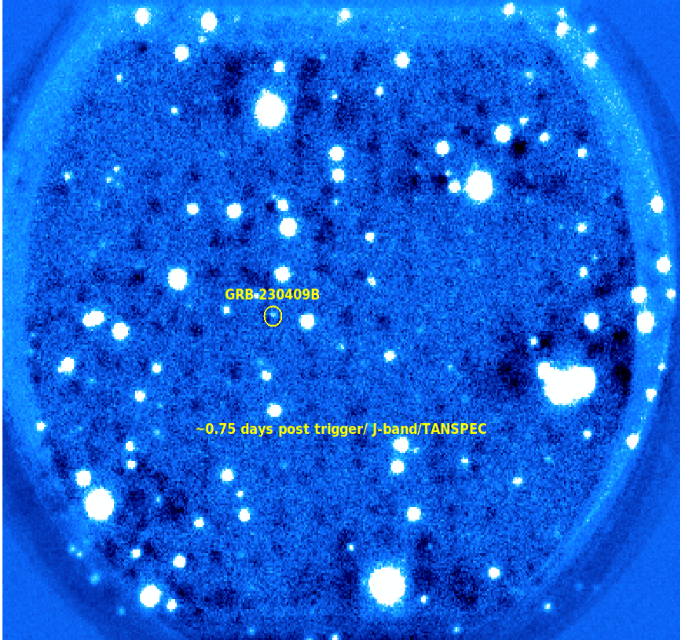
India has been actively involved in the follow-up observations of optical afterglows of gamma-ray bursts (GRBs) for more than two decades, using the country’s meter-class facilities such as the 1.04 m Sampurnanand Telescope, 1.3 m Devasthal Fast Optical Telescope, 2.01 m Himalayan Chandra Telescope along with many others in the country, utilizing the longitudinal advantage of the place. However, since 2016, Indian astronomers have embarked on a new era of exploration by utilizing the country's largest optical telescope, the 3.6 m Devasthal Optical Telescope (DOT) at the Devasthal Observatory of ARIES Nainital. This unique telescope has opened up exciting opportunities for transient study. Starting from the installation itself, the DOT has been actively performing the target of opportunity (ToO) observations, leading to many interesting discoveries. Notable achievements include the contributions towards the discovery of long GRB 211211A arising from a binary merger, the discovery of the most delayed optical flare from GRB 210204A along with the very faint optical afterglow (fainter than 25 mag in g-band) of GRB 200412B. We also successfully observed the optical counterpart of the veryhigh-energy (VHE) detected burst GRB 201015A using DOT. Additionally, DOT has been used for follow-up observations of dark and orphan afterglows, along with the observations of host galaxies associated with peculiar GRBs. More recently, DOT's near-IR follow-up capabilities helped us to detect the first near-IR counterpart (GRB 230409B) using an Indian telescope. In this work, we summarise the recent discoveries and observations of GRBs using the 3.6 m DOT, highlighting the significant contributions in revealing the mysteries of these cosmic transients.
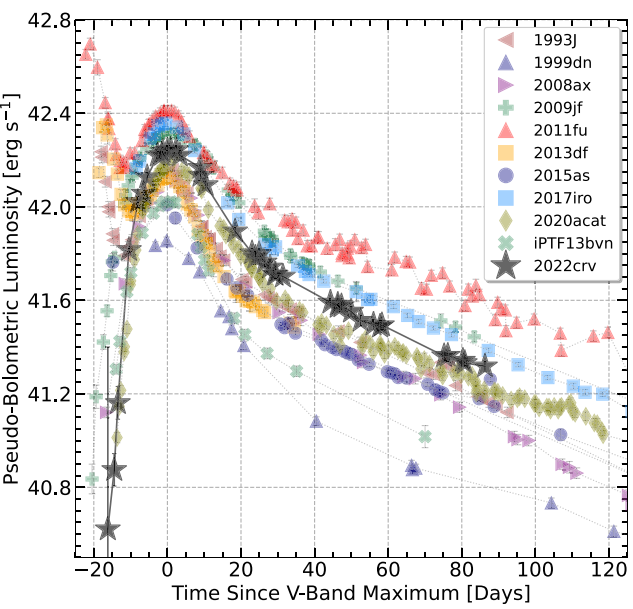
We present optical, near-infrared, and radio observations of supernova (SN) SN IIb 2022crv. We show that it retained a very thin H envelope and transitioned from an SN IIb to an SN Ib; prominent Hα seen in the pre-maximum phase diminishes toward the post-maximum phase, while He I lines show increasing strength. SYNAPPS modeling of the early spectra of SN 2022crv suggests that the absorption feature at 6200 Å is explained by a substantial contribution of Hα together with Si II, as is also supported by the velocity evolution of Hα. The light-curve evolution is consistent with the canonical stripped-envelope SN subclass but among the slowest. The light curve lacks the initial cooling phase and shows a bright main peak (peak M V = -17.82 ± 0.17 mag), mostly driven by radioactive decay of 56Ni. The light-curve analysis suggests a thin outer H envelope (M env ~ 0.05 M ⊙) and a compact progenitor (R env ~ 3 R ⊙). An interaction-powered synchrotron self-absorption model can reproduce the radio light curves with a mean shock velocity of 0.1c. The mass-loss rate is estimated to be in the range of (1.9-2.8) × 10-5 M ⊙ yr-1 for an assumed wind velocity of 1000 km s-1, which is on the high end in comparison with other compact SNe IIb/Ib. SN 2022crv fills a previously unoccupied parameter space of a very compact progenitor, representing a beautiful continuity between the compact and extended progenitor scenario of SNe IIb/Ib.
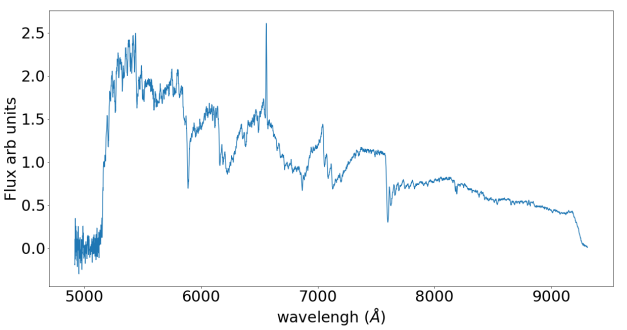
With the third data release of the Gaia mission, Gaia DR3 with its precise photometry and astrometry, it is now possible to study the behavior of stars at a scale never seen before. In this paper, we developed new criteria to identify T-Tauri stars (TTS) candidates using UV and optical color-magnitude diagrams (CMDs) by combining the GALEX and Gaia surveys. We found 19 TTS candidates and five of them are newly identified TTS in the Taurus molecular cloud (TMC), not cataloged before as TMC members. For some of the TTS candidates, we also obtained optical spectra from several Indian telescopes. We also present the analysis of distance and proper motion of young stars in the Taurus using data from Gaia DR3. We found that the stars in Taurus show a bimodal distribution with distance, having peaks at 130.17-1.241.31 pc and 156.25-5.001.86 pc. The reason for this bimodality, we think, is due to the fact that different clouds in the TMC region are at different distances. We further showed that the two populations have similar ages and proper motion distribution. Using the Gaia DR3 CMD, we showed that the age of Taurus is consistent with 1 Myr.
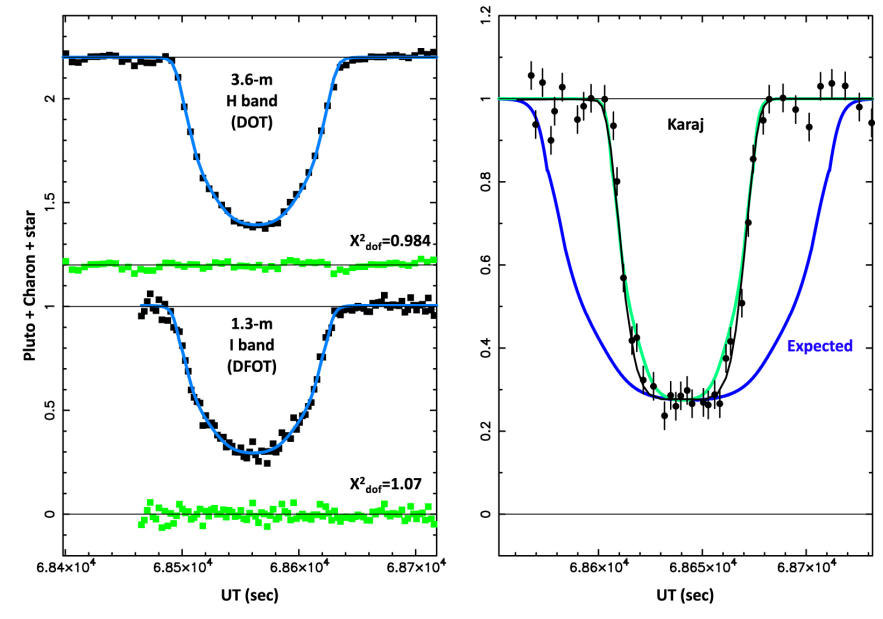
A stellar occultation by Pluto was observed on 2020 June 6 with the 1.3 m and 3.6 m telescopes located at Devasthal, Nainital, India, using imaging systems in the I and H bands, respectively. From this event, we derive a surface pressure for Pluto's atmosphere of psurf=12.23+0.65−0.38 μbar. This shows that Pluto's atmosphere has been in a plateau phase since mid-2015, a result which is in excellent agreement with the Pluto volatile transport model of Meza et al. This value does not support the pressure decrease reported by independent teams, based on occultations observed in 2018 and 2019 by Young et al. and Arimatsu et al., respectively.